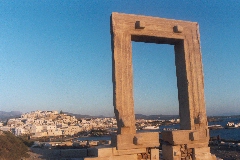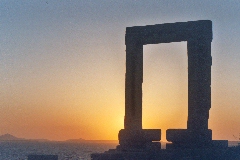|
Chóra (Náxos) and its surroundings |
||
| Evaluation:
These are a couple of short hikes through the village of Chóra: to the
kástro and the museum, to the Mitrópolis Site Museum and along the sea
to the first beaches. These hikes get an evaluation of **. Estimated time: It only takes a few minutes to get to the kástro or to the site of the Mitrópolis. The short walk along the harbour promenade and further on past the beaches takes about 40 minutes one way. Route description: To reach the kástro you can walk up from the harbour promenade at any point. The kástro dominates the town and in 1207 it was built by the Venetian Marco Sanudo, upon his return after the - partly unsuccessful - fourth crusade. The entrance on the north-western side still contains its original wooden gate; also the nearby Glezos-tower is impressive. Above the kástro you can find the catholic church and some catholic monasteries. Next to the church you can pay a visit to the very interesting archaeological museum (with among others some truly beautiful Cycladic statues). This museum used to be the Collčge français, and the famous writer Nikos Kazantzákis has studied here for some time. The museum is closed on Mondays though. Around the kástro you can admire some beautiful patrician houses, with decorated doors.
Tower on the kástro. To reach the site
of the Mitrópolis you should leave from the far end of the harbour
promenade, in between the statue of P. Protopapadákis and the bus
station. You take the street leading away from the sea, the Odós Iroöon
Politechníou, between the Zas travel agency and the pharmacy. After
about 150 metres, past the store with traditional products and fruits,
you leave this busy street. You go straight ahead/towards the right, in
order to get to the newly laid out space surrounding the recent
Mitropolis Site Museum. On the Mitrópolis-square you first walk on the
left-hand side of the museum that is largely constructed under the
ground. Further on you can also notice the Nikólaos-church and the
cathedral of Zoödóchou Pigís – all together there are four churches
on this square. The museum is not very large, it is very well organised and it contains really interesting remnants of houses dating from the Mycenian era (1400 - 1050 BC) – there are remnants of walls, of a very rare "pottery workshop" and of rests of funeral rituals dating from that time period and from later years. Because of the truly exceptional way of constructing you can walk over and between the remnants and…the visit of this museum is for free (it is open from 8 – 2.30pm, except on Mondays).
View to the kastro through the impressive Portara. |
To
have a look at the beaches south of Chóra, you should walk along the
harbour promenade and past the great number of restaurants for some five
minutes. You keep to the right of café Meltémi and you continue to
follow the promenade – unfortunately there is quite a lot of debris,
rusted iron and crumbled away foundations on this path. You pass underneath the "dímos Náxou" (the town hall) and after about ten minutes you can see the first little beach appearing in front of you. You walk on the left-hand side of a small, rocky cape in order to approach this beach. This is a fairly regular, but quite beautiful beach, with lots of restaurants, apartments and hotels. On the first part of this beach you can easily spend half a day to relax and to swim: there are a couple of trees and the sea is very shallow – great for children. If you continue
you will first walk through some sand dunes and after some fifteen
minutes you will thus reach the second part of the Agios Geórgios-bay
– this bay is well known among surfers. There are two centres for
water sports where you can rent surfboards. Also at this point the bay
is rather shallow. However, because of the surfers and the rocks just
underneath the water surface this is not really an ideal place to swim.
On the large
beach and also on the sand dunes beyond the beach quad riding is
sometimes practised. Some ten minutes
further down you can see a kind of dam on your left. Behind this dam
there seems to be a marsh or a lake with lots of water birds – however,
this nature site has been badly damaged because of the construction of
the airport at the end of the ‘80s. When you walk through the bed of a small river you can go to the bridge and the asphalt road on the left. You could follow this asphalt road in the direction of the Stelída-hill. At the junction you take a right and then you have to search for the right way; you continue along the water and then you climb up on the left, until you reach the top of the 150-metres-high hill – the view over the bay of Náxos is really beautiful from this spot. From this point you can continue further to the south, to the beautiful beaches of Agios Prokópios and Agia Anna, but this route is not very interesting for real hikers. Maybe, when the sun is about to set when you return, you could walk to the north-western end of the promenade, past the bus station. Over there you could then cross the dam to walk to the little island with the Portára – this impressive gate is all that rests from the – never finished – temple of Apollo. This monument definitely tells us about the hey-days of Náxos – in the 6th century BC there might even have lived about 100 000 people on this island. At sunset you can make wonderful pictures from this point.
Sunset from near the Portára.
In
order to get the printer-friendly version
|
|


